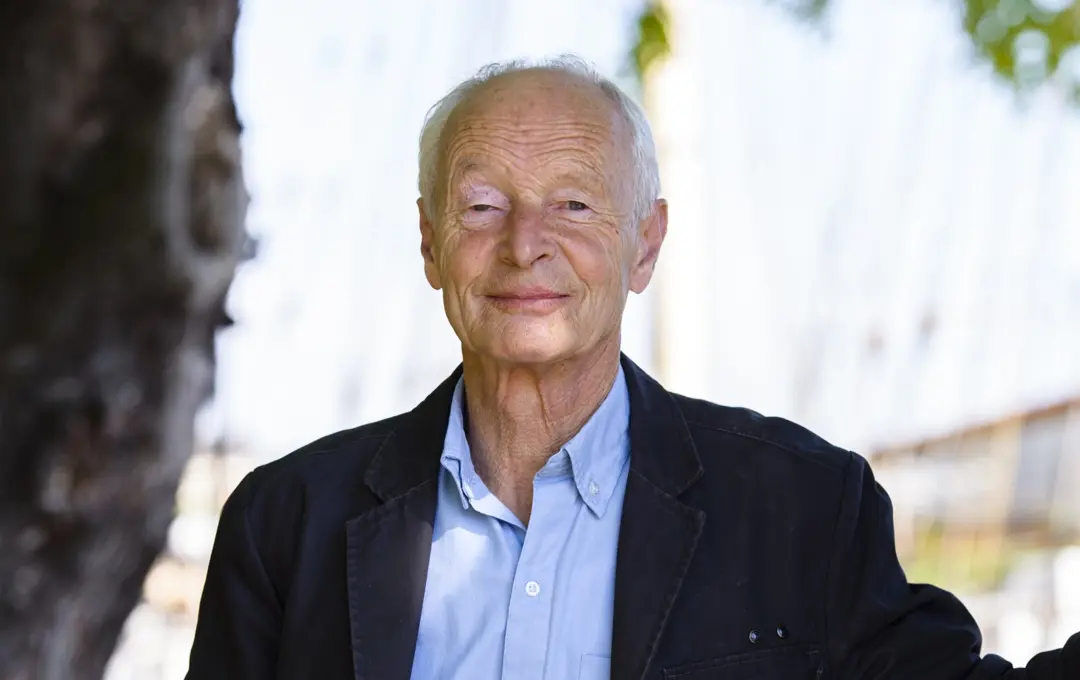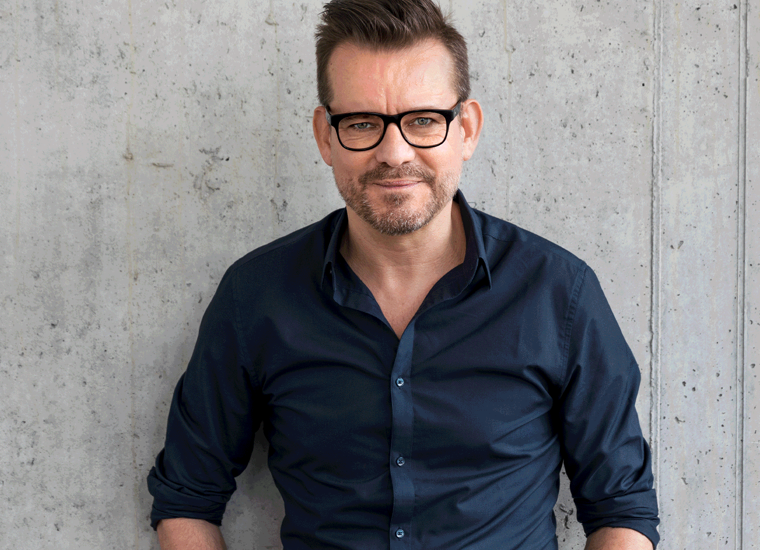Razor-sharp realism with warmth
Guus Kuijer is a Dutch author who portrays both the problems facing contemporary society and life’s big questions. He debuted in 1975 and has published over 30 books for children and young adults, mostly for readers in their early teens. The consistent message of his books is one of tolerance, understanding and broad-mindedness.
 Photo: Stefan Tell
Photo: Stefan TellQuick facts
The jury’s motivation
With an unprejudiced gaze and a sharp intellect, Guus Kuijer portrays both the problems facing contemporary society and life’s big questions. Respect for children is as self-evident in his works as his rejection of intolerance and oppression. Kuijer combines serious subject matter and razor-sharp realism with warmth, subtle humour and visionary flights of fancy. His simple, clear and precise style accommodates both deep philosophical insight and graceful poetic expression.
Guus Kuijer is an author, born in 1942, who lives and works in the Netherlands.
Guus Kuijer made his debut as a children’s author in 1975 and has published over 30 titles, mostly aimed at readers on the cusp of their teenage years. Key works include Het boek van alle dingen (2004, The Book of Everything), Florian Knol (2006) and the series of five books about the girl Polleke, starting with Voor altijd samen, amen (1999, Together Forever, Amen).
The uncompromising perspective of the child is always present in Kuijer’s works, but at the same time, through his young protagonists, he paints a perceptive picture of the adult world. His commitment extends to social and religious issues alike, and the consistent message of his books is one of tolerance, understanding and broad-mindedness.
Guus Kuijer has won a number of literary prizes, including the Deutsche Jugendliteraturpreis (German Children’s Literature Award) on two occasions. He is a four-time recipient of the Netherlands’ largest children’s literature prize, the Gouden Griffel (Golden Pencil), and has also received the Staatsprijs voor kinder- en jeugdliteratuur (Dutch National Award for Children’s and Young Adult Literature).
His works have been translated into more than 10 languages, including English, Swedish, German, Italian and Japanese.
The Astrid Lindgren Memorial Award was presented to Guus Kuijer at a ceremony at the Stockholm Concert Hall on 28 May 2012.
The phone call from the jury
Deep philosophical insight and graceful poetic expression
This text was written in 2012 by members of the award jury.
Guus Kuijer, born 1942, grew up in a strictly religious home in Amsterdam. He did not enjoy school but nevertheless decided to train as a primary teacher. He taught for six years until 1973, when he published his first novel and became a full-time writer. Two years later, he made his debut as a children’s author with Met de poppen gooien (1975, Daisy’s New Head). Kuijer has published over 30 books for children and young adults, mostly for readers in their early teens. Several of his works have been adapted for film or stage.
Early in his career, Guus Kuijer became active in the public debate. In the early 1980s he published a collection of essays dealing with how children are perceived by society, Het geminachte kind (1980, The Despised Child). In recent years, some of his writings have covered issues relating to intolerance and fundamentalism – hot topics in today’s Netherlands.
Respect for the child as an individual permeates Kuijer’s entire literary production. He addresses children with the same degree of seriousness and openness as if they were adults, and does not avoid difficult subjects. The consistent message of his books is one of tolerance, understanding and broad-mindedness.
His commitment extends to social and religious issues alike. Kuijer strongly repudiates religious dogmatism but leaves the door open to private experiences of a transcendental, existential nature. The characters he creates sometimes enter imaginary worlds of equal importance to the real world. He combines openness and sharp intellect with great understanding of the importance of the imagination.
In his debut work, Met de poppen gooien, we catch glimpses of what would later become typical features of Kuijer’s writing: a strong female protagonist who speaks her mind, and a keen eye for social issues. The book was the first in a series of five about nine-year-old Madelief, published between 1975 and 1979. The fourth title, Krassen in het tafelblad (1978, Scratches on the Tabletop), in which Madelief tries to find out why nobody liked her late grandmother, attracted particular attention. The picture that emerges is one of a woman who was never able to fit in with convention and the traditional role of wife and mother. The Madelief series enjoyed great success.
Kuijer’s next work, the satirical Hoe Mieke Mom haar maffe moeder vindt (1978, How Mieke Mom Finds Her Wacky Mother), provoked a certain amount of discussion. Mieke Mom is a completely different kind of children’s book – one that many people found provocative, not only because of its absurd style, but especially because of its ruthless criticism of the way the adult world relates to children.
Guus Kuijer’s major breakthrough came with the five books about the girl Polleke, published between 1999 and 2001. In the first book, Voor altijd samen, amen (1999, Together Forever, Amen), the 11-year-old Polleke herself is the narrator. Here Kuijer widens the social perspective to take in some of the challenges of modern society: ethnic tensions, drug abuse and new family structures. All this and more is part of Polleke’s world. Without ever moralizing, Kuijer lets Polleke observe the world through clear eyes, enabling the reader to do likewise.
Like so many of Guus Kuijer’s other works, the Polleke series is aimed at readers on the cusp of their teenage years. The protagonists are confronted both with current social issues and with life’s big questions. In Kuijer’s works, children are individuals with their own opinions and thoughts that deserve to be taken seriously.
Kuijer’s two most recent children’s books, Het boek van alle dingen (2004, The Book of Everything) and Florian Knol (2006), are more fanciful in character. The former is set in 1951 and tells the story of nine-year-old Thomas, born the same year as Kuijer. Thomas has a strictly religious father, who abuses both his wife and his son. Abhorrence of tyranny and religious dogmatism permeates the book, but there is also room for humour and warmth. Even in this story of autocratic power, the underlying perspective is optimistic. Thomas’ only wish is to be happy when he grows up, and he discovers that the route to happiness is to stop being afraid.
Het boek van alle dingen is, like the Polleke series, firmly rooted in the era in which it is set, but in this case there is also a transformation of reality that allows for surreal imagery and visionary flights of fancy. While Thomas moves seamlessly between reality and fantasy, his father has lost all notion of what it is like to be a child and the difference between right and wrong. Het boek van alle dingen is about what happens when one loses oneself and one’s capacity for independent thought. As is typical in Kuijer’s works, the dialogue carries the story and contributes to the subtle and sensitive characterization.
The mixture of reality and fantasy recurs in Florian Knol. Florian is a philosophical young man of about 10 who discovers that what is normal for one person may seem strange to another. A sparrow takes up residence one day in Florian’s red hair, but it soon turns out that the sparrow actually lives in the hair of an old lady, also a redhead. The old lady has dementia, as Florian and his classmate Katja soon realize. But how can they help her? And is it really any stranger to refer to keys as forks than to drink beer for breakfast like Katja’s father? Florian realizes that there are some problems that adults have to fix for themselves, but that friendship across the generational divide is both possible and rewarding.
The uncompromising perspective of the child is a consistent feature in Guus Kuijer’s works, but at the same time, through his young protagonists, he paints a perceptive picture of the adult world. With humanity and warmth he portrays a complex world in unpretentious yet subtle language.

“Once, a boy told me that to him reading was like bungy jumping inside his head, I therefore wish you all a great bungy jumping season.”
Acceptance Speech by Guus Kuijer
Discover our laureates
The Astrid Lindgren Memorial Award is awarded to authors, illustrators and narrators, but also to people or organizations that work to promote reading.
Find out more about the laureates
Children have the right to great stories
To lose yourself in a story is to find yourself in the grip of an irresistible power. A power that provokes thought, unlocks language and allows the imagination to roam free. The Astrid Lindgren Memorial Award was created in 2002 by the Swedish government to promote every child’s right to great stories.
Find out more about the award